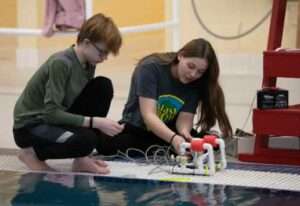
Middle school students got an opportunity to engage directly in ocean science as they constructed remotely operated vehicles in February as part of a science class project in Southeast Alaska. Petersburg Middle School science teacher Hannah Smith built ROVs with her students at her previous school in Washington and was excited to try them out with her students in Alaska.
“I used the Alaska Waters curriculum from Alaska Sea Grant to teach a modified version of their Oceans in Motion unit,” Smith explained. “ROVs fit perfectly with this unit because it is a real-life application of the technology scientists are using to explore the ocean while highlighting the different STEM skill sets that are relevant to building and operating underwater ROVs.”
Smith contacted Alaska Sea Grant Marine Advisory Program agent Sunny Rice in Petersburg to help explore possibilities for purchasing building kits. With Alaska Sea Grant providing funds to get the unit started, Smith and Rice worked together to plan and implement the project. They determined the best timing for the project, reserved the community swimming pool for the final ROV testing and competition, and recruited parents and other members of the community to help with the building process. Bringing parents into the seventh grade classroom was particularly important to Smith, because she will be working with those same students for eighth grade.
“I have had more parents than I have ever seen volunteer, and so many parents came and watched their children compete,” Smith said.
Parents with technical skills like soldering, plumbing and electronics were not difficult to find in a fishing community like Petersburg, and they were excited to join their kids in the Petersburg High School shop. One parent, a commercial fisherman, provided a fish tote full of water for the kids to use for testing before their official day in the pool.
After two weeks cutting, drilling, soldering, waxing, taping, wiring and constructing ROVs, the students participated in a final competition in early February. Parents and community members judged the vehicles based on speed, maneuvers through a suspended hula-hoop obstacle, and picking up items on the pool floor. Students learned about buoyancy as they added foam or weights to allow their ROVs to complete tasks. Local elementary school swimming students watched the proceedings from above and below the water while listening to presentations about the ROVs provided by the seventh graders.
Smith and Rice hope to hold a similar competition with the neighboring community of Wrangell in future years, tapping into the friendly rivalry between the two schools. Tools, batteries and other portions of the kits can be reused, while other materials can only be used once. Alaska Sea Grant provided all reusable and single-use parts this year, reducing the cost for future years.
“I can’t wait to continue working with Sunny to build and grow this project over the years,” Smith said. “I am so appreciative to Alaska Sea Grant for funding this in its initial year to get it started.”
